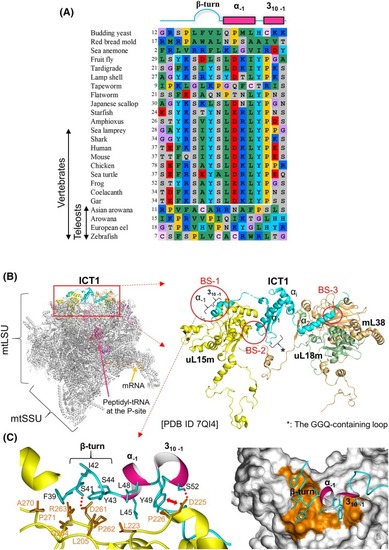
Binding of human ICT1 to a mitoribosome as an integral ribosomal protein and the characteristic binding motif at the N terminus. (A) Amino acid sequence alignment resides for the YSLDK motif at the N terminus among ICT1 proteins from various eukaryotes. The YSLDK motif resides are indicated by a box with white lines. Above the alignment, the secondary structure elements formed by the YSLDK motif residues found in human ICT1 are shown. For C. elegans ICT1, the N‐terminal region is short; therefore, the sequence is not shown. The alignments were performed using the clustalw program [58]. Alignment of the full‐length sequence of the ICT1 proteins is shown in Fig. S5. Accession codes for the ICT1 proteins used are provided in the legend of Fig. S5. The numbers to the left of the alignment correspond to the number of the first amino acid in each ICT1 protein. Alignments are colored as follows: purple: glycine (G); yellow: proline (P); green: small and hydrophobic amino acids (A, V, L, I, M); pink: hydrophobic aromatic residues (F, W); gray: hydroxyl and amine amino acids (S, T, N, Q); red: negatively charged amino acids (D, E); blue: positively charged amino acids (K, R); pale pink: cysteine (C); cyan: histidine (H) and tyrosine (Y). (B) Left: Overall structure of a human mitoribosome containing mRNA, tRNA in the P‐site, and ICT1 as a ribosomal protein in a ribbon representation. The structures in this figure are all based on PDB ID 7QI4 [44]. Ribosomal proteins and rRNAs in the mitoribosome are depicted in gray, while the others are indicated by arrows. Right: costructure of ICT1 (aquamarine) and the three ribosomal proteins, uL15m (yellow), uL18m (forest), and mL38 (light brown), which are extracted and engaged from the structure in the left panel. BS‐1, ‐2, and ‐3 (circled in red) indicate the major binding sites of ICT1 to the three ribosomal proteins. The structure of BS‐1 is illustrated in (C), while those of BS‐2 and BS‐3 are in Fig. S6. The program pymol (PyMOL Molecular Graphics System, Version 2.0, Schrödinger, LLC) was used to visualize and analyze the structures. (C) Left: Enlarged view of BS‐1. Side chains of nine residues of the characteristic binding motif of ICT1, the YSLDK motif, are shown; α‐ and 310‐helixes are depicted in pink. Side chains of residues in uL15m interacting with the motif residues are shown. Red dotted lines show a putative hydrogen bond, while a two‐red way arrow indicates a putative anion‐π interaction. Right: Molecular surface representation showing the interaction region of uL15m (depicted by orange) with a ribbon representation of the YSLDK motif residues. The program molmol [59] was used to visualize and analyze the structures.
|

